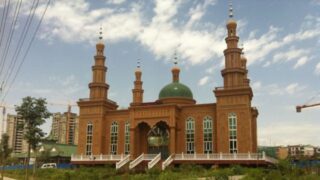Photos and testimonies from residents in Xinjiang’s Kashi prefecture expose details of facilities used by the CCP to detain millions of innocent people.
by Chang Xin
A resident of Xinjiang’s Kashi prefecture, home to about four million people, 90 percent of whom are Uyghurs, sent Bitter Winter a collection of photos of three transformation through education camps in the prefecture’s Shache county taken a year ago. (The images are used as illustrations throughout the text). Because the areas around the three camps are dotted with HD surveillance cameras and are closely guarded, the man could not get closer to see the full picture. But the accounts of some county residents help to get a better understanding of what these facilities are like.


A local man told Bitter Winter that every township in Shache county has a transformation through education camp, at least 20 in total. He added that one of the camps hires three local Uyghurs to bake naan bread for its detainees: more than one thousand pieces every day. Since only one naan is given to one person a day, it is rather easy to calculate how many people are held in the camp.


Outside a closed-down clinic, an elderly Uyghur told Bitter Winter that the clinic’s doctor “was taken to study” in an “education and training center” two years ago because he was a practicing Muslim and often went to the mosque to worship.


“I’ll get into trouble if I make careless remarks,” the man refused to answer more questions. He just pointed to a group of people holding sticks across the street, explaining that this was a local patrol team ready to beat up anyone who disobeys the government. “People are then arrested and detained,” the Uyghur added as he was getting on his motorcycle and left.
To accommodate the growing number of detainees, the Xinjiang government expanded the existing prisons. A source in Shache county revealed that three prisons, located several miles away from Korla city on the way to Luntai county, were expanded in the past few years. One of them has 17 buildings, including dormitories and factories. The prison can take in at least 6,000 detainees, 27 people kept in one cell on average.


According to the source, five prisons in the East Gobi Area near the Midong district’s Kaziwan sub-district in Urumqi, the capital of Xinjiang, were expanded between 2016 and the end of 2018. The man identified one of the prisons as the Xinjiang Uyghur Autonomous Region No. 3 Prison and the other as the region’s prison for women. The prisons had more than 20 new five-story buildings added, with 180-600 detainees kept on each floor.


Over 80 percent of detainees are Uyghurs, the majority sentenced from 7 to 10 years. While in detention, they are forced to study Mandarin and work in prison factories.











